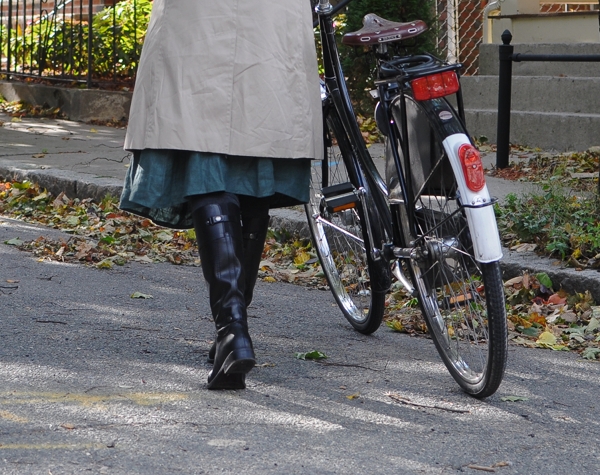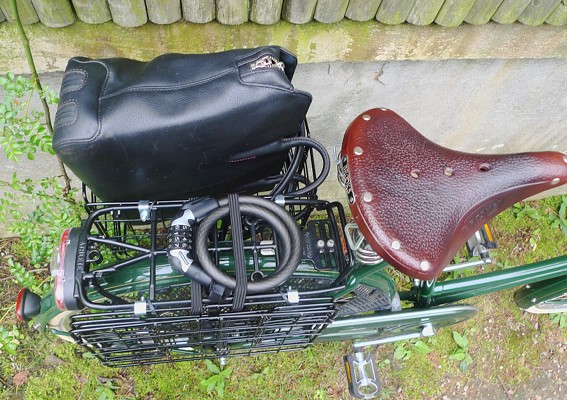A couple of my recent posts have generated some engaging commentary on "form vs function" and the validity of aesthetic preoccupations in cycling. I put the phrase "form vs function" in quotation marks, because I do not view it as a dichotomy that needs to be resolved. For me, the two concepts are in a symbiotic relationship, whereby one enhances the other and is incomplete without the other. I readily acknowledge my interest in aesthetics. But I stop well short of putting aesthetic factors before practical ones, which I hope comes across clearly throughout Lovely Bicycle.
There are three basic qualities that matter to me in a bicycle, and these qualities are functionality, comfort, and aesthetics. All three are essential for me, and I could not love a bicycle if either were lacking.
To me, functionality means that a bicycle must be good at what it was designed to do. For instance, a racing bicycle is designed with the goal of winning races. It therefore must possess qualities such as the ability to gain speed quickly and extreme maneuverability. Anything in the design of a racing bicycle that detracts from its ability to win races is a functional flaw. By the same token, an urban transport bicycle is designed to serve as a viable means of transportation for the city dweller. It therefore must possess features that enable the cyclist to comfortably and conveniently travel in everyday clothing, to observe their surroundings, to securely transport their bags and packages, and to travel in the dark. Anything in the design of an urban transport bicycle that detracts from this is a functional flaw.
Because functionality is a factor of individual needs, it is subject to great variability. Just as there are different types of bicycle racers, so are there different types of urban commuters. A diplomat who wears crisp skirt-suits and freshly-polished shoes to work and has a 2-mile commute will likely require different features from a transport bike than a computer programmer who wears jeans, sweaters and sneakers and has a 12-mile commute. A bicycle's functionality can only be evaluated in the context of its intended use.
And of course, regardless of what kind of cycling a bicycle was designed for, functionality means that everything should be working properly: structurally sound frame, proper assembly, and quality components.
The notion of comfort is equally important, and equally subjective. We need to be comfortable on a bicycle in order to enjoy riding it, or even to tolerate riding it. The more comfortable we are, the more we ride, and the safer our cycling behaviour. An uncomfortable bicycle can make commuting, touring and even racing a nightmare. There are many, many factors that go into what makes a bicycle comfortable - from the geometry and material of the frame, to the positioning of the saddle and handlebars, to other, more elusive aspects.
Being comfortable on a bicycle involves, first and foremost, being pain-free. In particular, pain in the hands, knees, butt, crotch and neck are the sort one should not be experiencing while cycling, as it can cause injury.
Comfort also means that a cyclist should feel good about their ability to control and handle their bicycle: to mount and dismount, to balance, to pick up speed in the manner they want, to handle turns, to climb hills, to control descents, to make emergency stops, to carry a load, and to cycle through traffic. And while to an extent all of this certainly depends on the cyclist's skill level, it also very much depends on the bicycle. A given cyclist may be comfortable doing these things on one type of bike, but not on another. I am a firm believer in finding a bicycle that both feels good to ride, and matches your skill level and comfort zone, rather than attempting to adapt to a bicycle that does not feel right.
Finally, I believe that the aesthetics of a bicycle are no less crucial in the enjoyment of the overall cycling experience. Put simply, aesthetics is how appealing or attractive we find the bicycle to be. Do we enjoy looking at it? Does it fill us with excitement and pleasure? Do we feel compelled to touch it, to ride it? It is about an emotional response, and it is about individual definitions of beauty.
Though some are more aware of it than others, the aesthetic experience is a natural part of our everyday lives. As we move through our environments and go about our daily activities, we are always looking and always responding with some degree of emotionality - whether it is positive, negative, or some form of confusion. Almost nothing leaves us entirely indifferent, unless we do not notice it. We prefer certain colours over others, certain shapes over others, certain spaces over others, and certain faces over others. Aesthetics are not just for the frivolous or the rich; they are not something you are aware of only when looking at paintings or choosing expensive curtains. All ordinary objects and everyday experiences have aesthetic qualities, and being able to extract these qualities can bring joy and fulfillment to the way we experience life.
Needless to say, what we consider "aesthetically pleasing" is extremely subjective, probably even more so than comfort and functionality. To some extent, it has to do with our inherent sense of harmony, symmetry, and balance, as well as with the associations evoked by the given object. Suffice to say, beauty is in the eye of the beholder.
The importance of functionality, comfort and aesthetics in the cycling experience extends beyond their individual roles; it is the interaction of the three that is crucial. How useful is the functionality of a bicycle that is not comfortable? How useful is the comfort of a bicycle if it is not functional? What good is a beautiful bicycle that is either uncomfortable or non-functional? And how sad it is for a bicycle to be functional and comfortable, but not excite you or make you smile? The most successful bicycle design is one where functionality, comfort, and aesthetics intersect. The graceful sweep of a loop frame is not only visually pleasing, but allows easy step-through. A handle bar bag secured to a randonneur-style front rack is not only handsome, but extremely useful on long trips. Form and function are best enjoyed as a happy couple.
In my posts on Lovely Bicycle, I do not pretend to be "everyman" or the voice of other cyclists. Far from it! I am a kooky, peculiar person with an unconventional lifestyle and profession, and I am comfortable with that. Neither do I make prescriptive statements about what kinds of bicycles other people should like or should be riding. Personally, I love bicycles that are functional, comfortable, and beautiful - and that is what I write about. You may relate, or you may not. Life is all about personal preferences.










0 comments:
Post a Comment